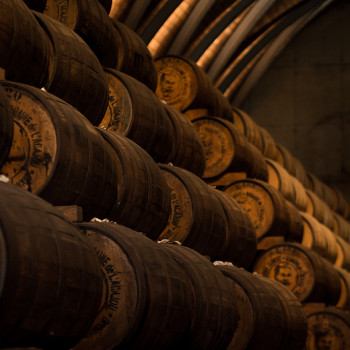TYPES OF CASKS

Discover the different types of whisky barrels and their impact on the final taste.
Whisky distilleries are now using a wider and more specific range of wine casks, with some expressions even specifying the winery. While there are more whiskies finished in wine casks than those undergoing full maturation, red wine casks are used much more frequently than white. In countries where wine and whisky are produced, such as Australia and South Africa, a unique form of cooperation is possible.
In South Africa, for example, a partnership has produced Three Ships 15-Year-Old Pinotage Cask Finish, which has a palate of red berry fruit, banana, and pineapple due to the use of Pinotage grapes, a local variety created by crossing Pinot Noir with Cinsaut.
In Scotland, Glenmorangie has been at the forefront of using wine casks for both full maturation and finishing, under the guidance of Dr Bill Lumsden, a wine and malt whisky enthusiast. Their impressive range of releases includes Margaux Cask Finish, a Tain l’Hermitage Finish, and Cote de Nuits Finish. Glenfiddich Winter Storm is finished with ice-wine casks from Peller Estate, a renowned winery in Niagara, Canada, adding a touch of sweetness and complexity with tropical fruit notes.


Beer casks are increasingly being used to either fully mature or provide additional traits for whiskies from Scotland, Ireland, Switzerland, Germany, and Finland, imbuing them with additional characteristics. The impact of the beer cask is determined by various factors, including the beer style, duration of time in the cask, as well as the whiskey's character and time spent in the cask. The influence is greater when the beer is richer and the whiskey is lighter. Glenfiddich made history in 2016 by becoming the first Scottish single malt to be finished in IPA (India Pale Ale) casks, which were brewed with zesty citrus and tangy hops in Speyside, the same region where Glenfiddich is produced.
Meanwhile, in Finland, Teerenpeli distillery, which shares the same owner as a nearby brewery, uses porter beer casks that are quickly filled with whisky and then refilled with porter for up to four months. The casks are then either filled with new-make spirit for full maturation, adding toastiness and maltiness, or with mature whisky for finishing, which results in a milder influence from the cask.
Sherry casks are responsible for infusing flavors such as apricots, raisins, vanilla, cinnamon, gingerbread, fruit cake, and Christmas pudding into whisky. These casks are seasoned based on agreements between whisky distillers and bodegas, which dictate the type of oak, toasting level, cask size, sherry style used to season the cask, and seasoning period (usually two years). American and European oak are the main choices, with Spanish oak from Galicia providing a stronger influence during ageing due to higher levels of dried fruit, spice, and tannins compared to American oak, which has a more delicate influence with abundant vanilla. Casks are usually seasoned with oloroso sherry, which provides more floral aromas and fruitiness than spice.
Malt whisky distilleries such as Tarndhu and Glenfiddich exclusively use oloroso casks, while fino, the driest sherry style, is rarely used. Manzanilla casks provide salty, salted caramel, and raisin notes, which balance sweetness, while Pedro Ximenez (PX), the richest style, gives quick results, with a 9-12 month finish in a PX cask sufficient to gain raisins, dried fruit, dark chocolate, sweetness, richness, and spice
When sherry casks arrive at whisky distilleries, indrink (residual liquid) remains absorbed within the staves, providing an oak extractive liquid that used to be considered a major influence but is now considered one of many influences.


Bourbon exclusively uses standard American casks made of white American oak, which is charred on the inside and has a capacity of 200 liters. The oak for these casks comes from forests in Missouri, Arkansas, and Kentucky, and is selected based on age and sustainability.
After being sawn into timber, the oak is air-dried for around 12 months, allowing tannins to leach out and fruit and spice notes to develop. The dried wood is then cut into staves and made into casks at a cooperage, where the interior is charred.
Bourbon casks can only be used once, and the residual liquid left inside is a significant influence on the flavor of the whisky. When the casks are sold to other whisky producers, they have been "seasoned" by the Bourbon, reducing the impact of the oak on the whisky's flavor.
Overall, the cask plays a crucial role in shaping the character and complexity of the final whisky product.
Source: The Whisky Dictionary: an A-Z of Whisky, from history & heritage to-distilling & drinking






